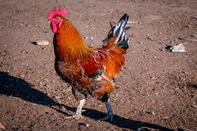
Distribution of Birds

When entering the production area, look at the distribution of birds. Birds that are cold will huddle together, while birds that are hot will collect in cooler areas and either stand or lie down and gasp in an attempt to cool themselves.
Crowding at feeders or drinkers might indicate that there are not enough drinkers or feeders, which will result in competition and weak birds always receiving less water or food than their stronger counterparts. Draughts may also result in birds collecting in draught-free areas.
General Appearance

Look at the general appearance of the birds. Do they look healthy, depressed or bedraggled. Are there signs of feather pecking? Do you see bald patches on the birds? Look at the size of the birds.
Are all birds the same size or are some smaller than others? What could be the reason for this differences? Were some of the birds weak to start with, are they sick or are stronger birds preventing them from getting to the feed?
Different Body Parts
Next you need to inspect different parts of the body from head to tail.Head and Neck

The comb and wattles should be red, without any cutting or swellings. Something is wrong if the comb or wattles are blue or black, while a pale pink colour may indicate sickness, parasite infestations, heat exhaustion or simply that the bird is undergoing its annual molt, a biological process during which they lose their feathers and grow new ones.
The eyes should be round, open and sparkling. Something is wrong when the eyes are closed, oval shaped, a dull white colour or there is a discharge. The nostrils should be clean and open to allow normal breathing. There should not be any fluid running from the nostrils, as this may cause crusts that can block the nostrils.
The area between the eyes and nostrils should not be swollen. When looking at the beak, it should be a normal shape without any missing parts except if it is a layer since suppliers trim the top part of the beak to prevent layers from pecking each other in the cages.
The beak is usually closed during normal conditions, but will be open with the bird breathing fast when the nostrils are blocked, the bird is under stress or feeling too warm. The beak should not feel soft and rubbery. The neck should be strong and straight to keep the head high. It should not be weak and twisted.
Body

The entire body should be covered by feathers, except for some breeds where the neck and chest may be bare. The feathers are normally flat against the body and only raised when birds sleep, in cold weather or during sickness. Check between the feathers for ticks, lice and mites.
Ticks are usually found around the head and lice on the feathers of the neck and on or beneath the wings. The feathers should be clean. Dirty feathers with droppings around the vent may be an indication of diarrhoea.
Swelling around the vent may be an indication of an egg that cannot pass. The legs should be strong, straight and smooth, usually with a yellow colour. There should not be any cuts, swelling or crusts on the legs and the birds should be walking normally, without limping.
By Glenneis Kriel